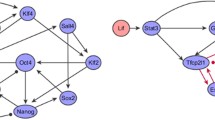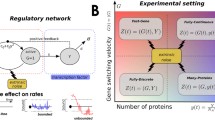Abstract
Cells impose optimal noise control mechanism in diverse situations to cope with distinct environmental cues. Sometimes, it is desirable for the cell to utilize fluctuations for noise-driven processes. In other cases, noise can be harmful to the cell to show optimal fitness. It is, therefore, important to unravel the noise propagation mechanism inside the cell. Such noise controlling mechanism is accomplished by using gene transcription regulatory networks. One such gene regulatory network is feed-forward loop, having three regulatory nodes S, X and Y. Here, we consider the most abundant type 1 of coherent and incoherent feed-forward loops with both OR and AND logic functions, forming four different architectures. In OR logic function, the functions representing S and X act additively for the regulation of Y, while in AND logic function, the same functions (S and X) act multiplicatively for the regulation of Y. Measurement of susceptibility of the signal at output Y is done using elasticity of each regulation in FFLs. Using susceptibility, we demonstrate the nature of pathway integration by which one-step and two-step pathways get overlapped. The integration type is competitive for motifs having OR gate, while it is noncompetitive for the same with AND gate. The pathway integration property explains the output noise behavior of the motifs properly but cannot infer about the mechanism by which the upstream noise propagates to output. To account this, the total output noise is decomposed, which results in integrated noise as an additional noise source along with pathway-specific noise components. The integrated noise is found to appear as a consequence of integration between the pathways and has different functional characteristics explaining noise amplification and noise attenuation property of coherent and incoherent feed-forward loops, respectively. The noise decomposition also quantifies the contribution of different noise sources toward total noise. Finally, the noise propagation is being tuned as a function of input signal noise and its time scale of fluctuations, which shows considerable intrinsic noise strength and relatively slow relaxation time scale causes a higher degree of noise propagation in FFLs.






Similar content being viewed by others
References
Alon U (2006) An introduction to systems biology: design principles of biological circuits. CRC Press, Boca Raton
Alon U (2007) Network motifs: theory and experimental approaches. Nat Rev Genet 8:450
Bialek W, Setayeshgar S (2008) Cooperativity, sensitivity, and noise in biochemical signaling. Phys Rev Lett 100(25):258101
Bintu L, Buchler NE, Garcia HG, Gerland U, Hwa T, Kondev J, Phillips R (2005) Transcriptional regulation by the numbers: models. Curr Opin Genet Dev 15:116
Burger A, Walczak AM, Wolynes PG (2010) Abduction and asylum in the lives of transcription factors. Proc Natl Acad Sci USA 107:4016
Carey L, van Dijk D, Sloot P, Kaandorp J, Segal E (2013) Promoter sequence determines the relationship between expression level and noise. PLoS Biol 11:e1001528
Carignano A, Mukherjee S, Singh A, Seelig G (2018) Extrinsic noise suppression in micro RNA mediated incoherent feedforward loops, bioRxiv
Cheong R, Rhee A, Wang CJ, Nemenman I, Levchenko A (2011) Information transduction capacity of noisy biochemical signaling networks. Science 334:354
Chevalier M, Venturelli O, El-Samad H (2015) The impact of different sources of fluctuations on mutual information in biochemical networks. PLoS Comput Biol 11:e1004462
Cover TM, Thomas JA (1991) Elements of information theory. Wiley-Interscience, New York
de Ronde WH, Tostevin F, ten Wolde PR (2010) Effect of feedback on the fidelity of information transmission of time-varying signals. Phys Rev E 82:031914
de Ronde WH, Tostevin F, Ten Wolde PR (2012) Feed-forward loops and diamond motifs lead to tunable transmission of information in the frequency domain. Phys Rev E 86:021913
Dey S, Soltani M, Singh A (2019) Enhancement of gene expression noise due to nonspecific transcription factor binding, bioRxiv
Dunlop MJ, Cox RS, Levine JH, Murray RM, Elowitz MB (2008) Regulatory activity revealed by dynamic correlations in gene expression noise. Nat Genet 40:1493
Elf J, Ehrenberg M (2003) Fast evaluation of fluctuations in biochemical networks with the linear noise approximation. Genome Res 13:2475
Gardiner CW (2009) Stochastic methods, 4th edn. Springer, Berlin
Ghosh B, Karmakar R, Bose I (2005) Noise characteristics of feed forward loops. Phys Biol 2:36
Gillespie DT (1976) A general method for numerically simulating the stochastic time evolution of coupled chemical reactions. J Comp Phys 22:403
Gillespie DT (1977) Exact stochastic simulation of coupled chemical reactions. J Phys Chem 81:2340
Gillespie DT (2000) The chemical Langevin equation. J Chem Phys 113:297
Grigolon S, Di Patti F, De Martino A, Marinari E (2016) Noise processing by microRNA-mediated circuits: the Incoherent Feed-Forward Loop, revisited. Heliyon 2:e00095
Grima R (2015) Linear-noise approximation and the chemical master equation agree up to second-order moments for a class of chemical systems. Phys Rev E 92:042124
Gui R, Liu Q, Yao Y, Deng H, Ma C, Jia Y, Yi M (2016) Noise decomposition principle in a coherent feed-forward transcriptional regulatory loop. Front Physiol 7:600
Gui R, Li ZH, Hu LJ, Cheng GH, Liu Q, Xiong J, Jia Y, Yi M (2018) Noise decomposition algorithm and propagation mechanism in feed-forward gene transcriptional regulatory loop. Chin Phys B 27:028706
Herranz H, Cohen SM (2010) MicroRNAs and gene regulatory networks: managing the impact of noise in biological systems. Genes Dev 24:1339
Honeycutt RL (1992) Stochastic Runge-Kutta algorithms. I. White noise. Phys Rev A 45:600
Hornung G, Barkai N (2008) Noise propagation and signaling sensitivity in biological networks: a role for positive feedback. PLoS Comput Biol 4:e8
Kaern M, Elston TC, Blake WJ, Collins JJ (2005) Stochasticity in gene expression: from theories to phenotypes. Nat Rev Genet 6:451
Kittisopikul M, Suel GM (2010) Biological role of noise encoded in a genetic network motif. Proc Natl Acad Sci USA 107:13300
Li X, Cassidy JJ, Reinke CA, Fischboeck S, Carthew RW (2009) A microRNA imparts robustness against environmental fluctuation during development. Cell 137:273
Maity AK, Chaudhury P, Banik SK (2015) Role of relaxation time scale in noisy signal transduction. PLoS ONE 10:e0123242
Mangan S, Alon U (2003) Structure and function of the feed-forward loop network motif. Proc Natl Acad Sci 100:11980
Mehta P, Goyal S, Long T, Bassler BL, Wingreen NS (2009) Information processing and signal integration in bacterial quorum sensing. Mol Syst Biol 5:325
Nandi M, Biswas A, Banik SK, Chaudhury P (2018) Information processing in a simple one-step cascade. Phys Rev E 98:042310
Nandi M, Banik SK, Chaudhury P (2019) Restricted information in a two-step cascade. Phys Rev E 100:032406
Osella M, Bosia C, Cora D, Caselle M (2011) The role of incoherent microRNA-mediated feedforward loops in noise buffering. PLoS Comput Biol 7:e1001101
Paulsson J (2004) Summing up the noise in gene networks. Nature 427:415
Paulsson J (2005) Models of stochastic gene expression. Phys Life Rev 2:157
Pedraza JM, van Oudenaarden A (2005) Noise propagation in gene networks. Science 307:1965
Rao CV, Wolf DM, Arkin AP (2002) Control, exploitation and tolerance of intracellular noise. Nature 420:231
Rhee A, Cheong R, Levchenko A (2014) Noise decomposition of intracellular biochemical signaling networks using nonequivalent reporters. Proc Natl Acad Sci USA 111:17330
Shannon CE (1948) The mathematical theory of communication. Bell Syst Tech J 27:379
Shannon CE, Weaver W (1963) The mathematical theory of communication. University of Illinois Press, Urbana
Swain PS (2004) Efficient attenuation of stochasticity in gene expression through post-transcriptional control. J Mol Biol 344(4):965
Tănase-Nicola S, Warren PB, ten Wolde PR (2006) Signal detection, modularity, and the correlation between extrinsic and intrinsic noise in biochemical networks. Phys Rev Lett 97:068102
Thattai M, van Oudenaarden A (2002) Attenuation of noise in ultrasensitive signaling cascades. Biophys J 82:2943
Thomas P, Matuschek H, Grima R (2013) How reliable is the linear noise approximation of gene regulatory networks? BMC Genom 14(Suppl 4):1–5
Tkačik G, Gregor T, Bialek W (2008) The role of input noise in transcriptional regulation. PLoS ONE 3(7):e2774
Tocino A, Ardanuy R (2002) Runge-Kutta methods for numerical solution of stochastic differential equations. J Comput Appl Math 138:219
Tsimring LS (2014) Noise in biology. Rep Prog Phys 77:026601
van Kampen NG (2007) Stochastic processes in physics and chemistry, 3rd edn. North-Holland, Amsterdam
Walczak AM, Mugler A, Wiggins CH (2012) Analytic methods for modeling stochastic regulatory networks. Methods Mol Biol 880:273
Warmflash A, Dinner AR (2008) Signatures of combinatorial regulation in intrinsic biological noise. Proc Natl Acad Sci USA 105:17262
Zhang Q, Bhattacharya S, Andersen ME (2013) Ultrasensitive response motifs: basic amplifiers in molecular signalling networks. Open Biol 3:130031
Ziv E, Nemenman I, Wiggins CH (2007) Optimal signal processing in small stochastic biochemical networks. PLoS ONE 2:e1077
Acknowledgements
MN is thankful to Suman K Banik and Pinaki Chaudhury for critical discussion. MN acknowledges UGC, India (22/06/2014(i)EU-V) for a research fellowship.
Author information
Authors and Affiliations
Corresponding author
Additional information
Publisher's Note
Springer Nature remains neutral with regard to jurisdictional claims in published maps and institutional affiliations.
Supplementary Information
Below is the link to the electronic supplementary material.
Rights and permissions
About this article
Cite this article
Nandi, M. Role of integrated noise in pathway-specific signal propagation in feed-forward loops. Theory Biosci. 140, 139–155 (2021). https://doi.org/10.1007/s12064-021-00338-6
Received:
Accepted:
Published:
Issue Date:
DOI: https://doi.org/10.1007/s12064-021-00338-6




